Live below your means. Intelligently invest your capital for the long run. It’s such a simple recipe for financial success. But it just plain works.
So what is intelligent investing? Well, dividend growth investing comes to mind right away. This is a strategy whereby you buy and hold shares in high-quality businesses that pay safe, growing dividends to shareholders.
You buy these shares when undervaluation is present. And then you hold for decades, reinvesting those growing dividends along the way. High-quality dividend growth stocks are some of the best stocks in the world.
That’s because they represent equity in some of the best businesses in the world. After all, the only way to fund ever-rising dividends is to produce the ever-rising profits necessary to afford that behavior. And only truly great businesses can produce ever-rising profits.
That said, you should be considering your age. Investing in your 40s isn’t exactly like investing in your 20s or your 70s. There are differences in aspects like time horizon, risk tolerance, income needs, etc.
If you’re in your 40s, you might be leaning just a bit more toward yield and income. Some of your dividend income being able to offset very real bills is nice.
But you also have to balance that income today against the future growth of that income and the underlying assets, which will protect the older version of yourself.
And that balance between yield and growth, slightly favoring yield, is what we’re diving into.
Today, I want to tell you about 3 dividend growth stocks to consider buying if you’re in your 40s.
Ready? Let’s dig in.
The first dividend growth stock I want to talk about is Mid-America Apartment Communities (MAA). Mid-America Apartment Communities is an apartment community real estate investment trust.
Want to own real estate without dealing with the massive headaches? Well, a REIT like this one allows you to do just that. When you buy shares in this REIT, you instantly own a slice of a large property portfolio that encompasses more than 100,000 units across approximately 300 different apartment communities.
We’ve all gotta live somewhere, right? Shelter is a basic need. It will always have built-in demand. We’re not gambling on some new technology here. And with houses near historic highs on pricing, and with mortgage rates being higher than they’ve been in years, apartments are looking pretty good. There’s one other very important aspect about this particular REIT that is so appealing.
Location, location, location. That’s the famous line when it comes to real estate, right? Well, Mid-America Apartment Communities has its portfolio positioned really well when it comes to location. Its communities are concentrated in some of the fastest-growing metros in all of the US.
This REIT is all about the Sunbelt. Some of its top markets are Tampa, Florida and Austin, Texas. Growing markets. And market growth has propelled this REIT and its stock higher. As of May 31, 2023, its 10-year compound TSR is 11.9%. Getting a 12% annual total return on a basic need? Not bad at all.
 Of course, a big part of that total return comes in the form of a big dividend. The stock yields 3.9% right now, which could certainly help out with some bills. But it’s not just yield here. There’s also pretty solid dividend growth. The REIT has increased its dividend for 13 consecutive years, with a 10-year DGR of 5.9%.
Of course, a big part of that total return comes in the form of a big dividend. The stock yields 3.9% right now, which could certainly help out with some bills. But it’s not just yield here. There’s also pretty solid dividend growth. The REIT has increased its dividend for 13 consecutive years, with a 10-year DGR of 5.9%.
You can see that we are leaning a bit more toward yield than growth here, which is what I outlined at the start of the article. Still, with a payout ratio of 68.1%, based on AFFO/share guidance, at the midpoint, for this fiscal year, the dividend appears to be quite safe and positioned for more growth ahead.
The stock is down by 7% on the year, and that’s created what looks like a favorable valuation. Based on that aforementioned guidance, the forward P/AFFO ratio is 17.7. That’s awfully undemanding for a premium sunbelt apartment REIT, in my view. The P/CF ratio of 14.7 is well off of its own five-year average of 20.
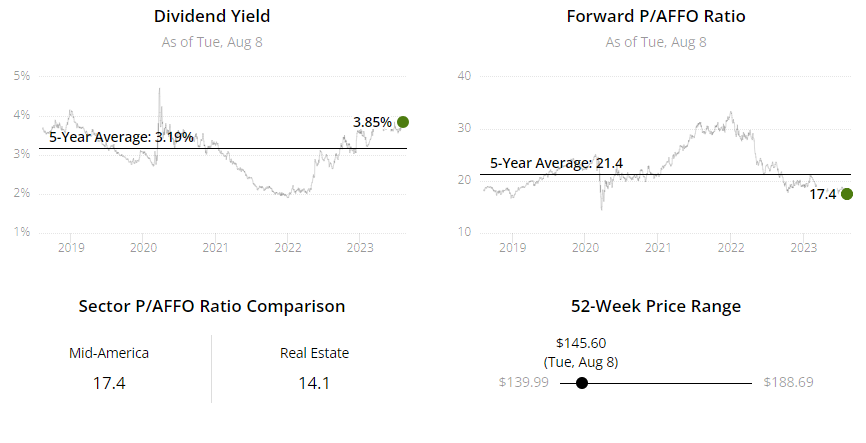 Now, the average is skewed by the pandemic and a different rate paradigm. But higher rates are arguably a tailwind for the business in some ways. Like I said, we’ve all gotta live somewhere. And if high rates and high prices make houses expensive, apartments become better by comparison. This has been a great investment over the last decade. The next decade sets up just as well, if not better.
Now, the average is skewed by the pandemic and a different rate paradigm. But higher rates are arguably a tailwind for the business in some ways. Like I said, we’ve all gotta live somewhere. And if high rates and high prices make houses expensive, apartments become better by comparison. This has been a great investment over the last decade. The next decade sets up just as well, if not better.
The second dividend growth stock to go over is Realty Income (O). Realty Income is a triple-net, diversified real estate investment trust.
Another REIT? What can I say? If you’re leaning a bit toward yield, REITs are a great vehicle for that. REITs, broadly speaking, tend to offer higher yields. That said, Realty Income is almost in its own category in some ways. This REIT has over 13,000 properties leased under long-term, net-lease agreements.
This has been one of the best and most successful REITs of all time. Since its 1994 IPO, it’s delivered a 14.2% compound annual total return. It’s steadily grown its portfolio into what is now a monster. It’s diversified in almost every way. It’s geographically diversified, as I just touched on. But it’s also diversified in terms of property type and industry exposure. We’re talking grocery stores, restaurants, gyms, automotive service, etc. The list goes on and on.
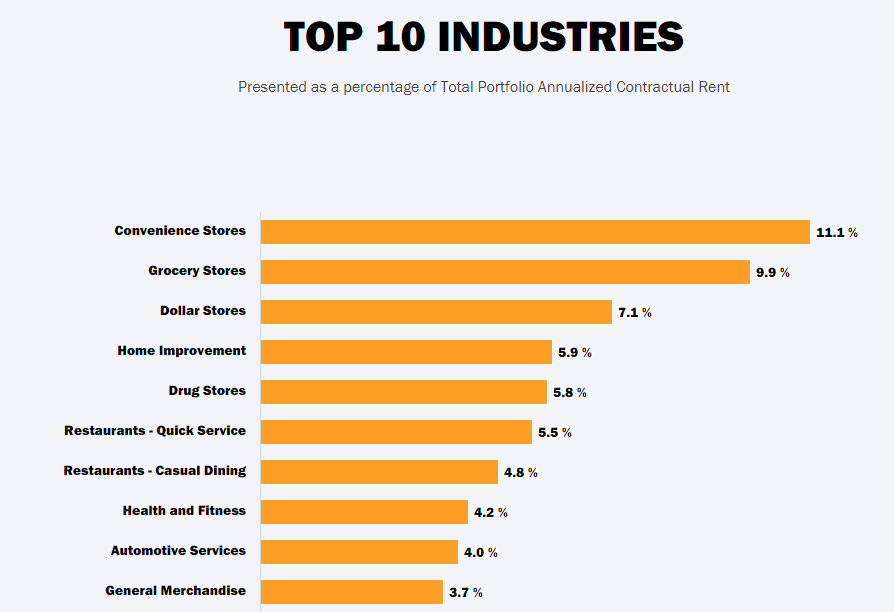 This is about as sleep-well-at-night as it gets. Realty Income sports a 99% occupancy rate. No one tenant makes up more than 4% of annualized rent. Super conservative. Super successful. Despite what you’ve heard about commercial real estate being in trouble, which is mostly a problem for older office buildings in poor locations, Realty Income’s portfolio is nearly bulletproof.
This is about as sleep-well-at-night as it gets. Realty Income sports a 99% occupancy rate. No one tenant makes up more than 4% of annualized rent. Super conservative. Super successful. Despite what you’ve heard about commercial real estate being in trouble, which is mostly a problem for older office buildings in poor locations, Realty Income’s portfolio is nearly bulletproof.
And that’s why the dividend is nearly bulletproof. By the way, this isn’t just a dividend. It’s a monthly dividend. Realty Income takes its monthly dividend commitment to shareholders very seriously. So seriously, in fact, that it trademarked its moniker: The Monthly Dividend Company.
You have gotta love that. Since its founding in 1969, it’s declared 637 consecutive common stock monthly dividends. Since its 1994 IPO, it’s increased the dividend 121 times. That’s good for 30 consecutive years of dividend increases, easily qualifying it for its Dividend Aristocrat status. The 10-year DGR is 5.3%, which is good. What’s better is the yield of 5.2%.
Realty Income is rarely this cheap. Higher interest rates have hit the business and the stock. Higher rates make capital more expensive, and REITs are always looking for external financing. That’s because they’re required by law to distribute at least 90% of their taxable earnings to existing shareholders.
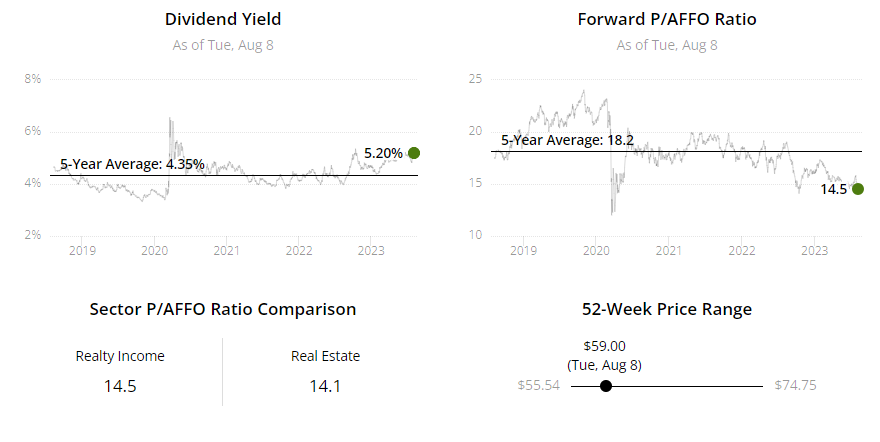 Plus, the higher rates have hit the stock, as alternatives now offer higher yields and compete for investors’ capital. The stock’s P/CF ratio is now 13.8. Outside of crises, that’s as low as I’ve seen it. Its own five-year average is 19.4. For bargain-hunter investors looking for a blue-chip REIT paying a large, monthly dividend growing at a good clip, Realty Income is an obvious long-term investment candidate right now.
Plus, the higher rates have hit the stock, as alternatives now offer higher yields and compete for investors’ capital. The stock’s P/CF ratio is now 13.8. Outside of crises, that’s as low as I’ve seen it. Its own five-year average is 19.4. For bargain-hunter investors looking for a blue-chip REIT paying a large, monthly dividend growing at a good clip, Realty Income is an obvious long-term investment candidate right now.
The third dividend growth stock that I have to highlight is Pinnacle West Capital (PNW). Pinnacle West is an American utility holding company.
There are a number of things to like about Pinnacle West. First, the business model. We’re talking about a power utility here. Try living without electricity for a day or two. Can’t really do it. Access to reliable power in a modern-day society is almost as important as access to reliable oxygen.
Investing in a utility is all about reliability. Customers want reliable energy. They’ve gotta have it. Shareholders want reliable results from the business. Because guess what? In this world, bills are very reliable. And when you’re in your 40s and maybe starting to think about slowing down at some point, the ability to rely on your investments becomes even more important.
Well, that’s what’s appealing about the utility business model. You’re investing in something that people can’t live without. The second thing to like about this utility?
Again, location, location, location. Pinnacle West is headquartered out in Phoenix, AZ and serves more than 1 million customers throughout Arizona. Arizona is one of the fastest-growing states in the US. And that growth has been powered by Phoenix, which is one of the fastest-growing cities in the US. In fact, Phoenix grew the fastest (in percentage terms) between 2010 and 2020, according to the most recent information from the US Census Bureau.
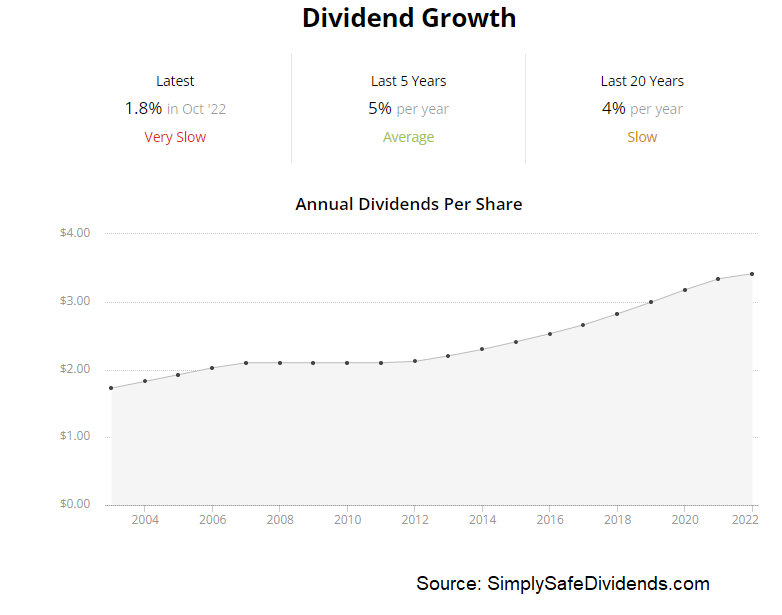 That combination of reliability and growth extends to the dividend. Pinnacle West has been a lock for a reliable and growing dividend for years now. The company has increased its dividend for 11 consecutive years. The 10-year DGR of 4.9% isn’t huge. But it outpaces some of the other large utilities out there. That said, we’ve got yet other thing to like about this utility: yield. The stock yields 4.5%. That’s pretty hefty income.
That combination of reliability and growth extends to the dividend. Pinnacle West has been a lock for a reliable and growing dividend for years now. The company has increased its dividend for 11 consecutive years. The 10-year DGR of 4.9% isn’t huge. But it outpaces some of the other large utilities out there. That said, we’ve got yet other thing to like about this utility: yield. The stock yields 4.5%. That’s pretty hefty income.
Utilities tend to offer higher yields in order to compensate for lower growth rates. In this case, a 4.5% yield backed by a 5% growth rate isn’t a bad combination at all, especially for income-oriented dividend growth investors. And if you’re in your 40s, maybe you’re starting to become more oriented toward income. The payout ratio is 82.4%, based on midpoint guidance for this fiscal year’s EPS. Elevated. But backed by a necessary business in a favorable location.
Another thing that looks favorable? The valuation. Here we go with one more thing to like about Pinnacle West. Almost every multiple is below its respective recent historical average. Take your pick. For instance, the sales multiple of 1.9 is below its own five-year average of 2.4.
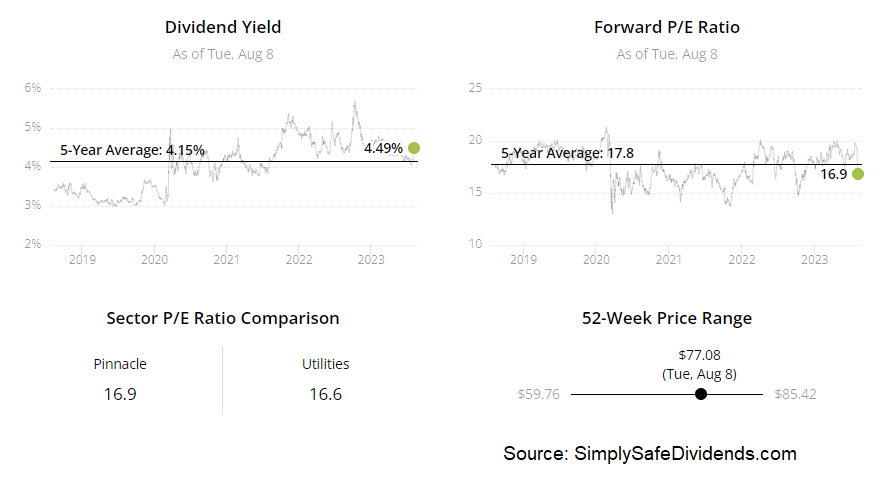 Based on that aforementioned guidance, the forward P/E ratio is 18.2. Quite reasonable for a good business in a great location. Also, it’s worth mentioning that the 4.5% yield is 50 basis points higher than its own five-year average. Higher-than-usual yield and a lower-than-usual valuation. Tough to dislike that. Take a look.
Based on that aforementioned guidance, the forward P/E ratio is 18.2. Quite reasonable for a good business in a great location. Also, it’s worth mentioning that the 4.5% yield is 50 basis points higher than its own five-year average. Higher-than-usual yield and a lower-than-usual valuation. Tough to dislike that. Take a look.
— Jason Fieber
P.S. Would you like to see my entire stock portfolio — the portfolio that’s generating enough safe and growing passive dividend income to fund my financial freedom? Want to get an alert every time I make a new stock purchase or sale? Get EXCLUSIVE access here.
Source: Dividends & Income
